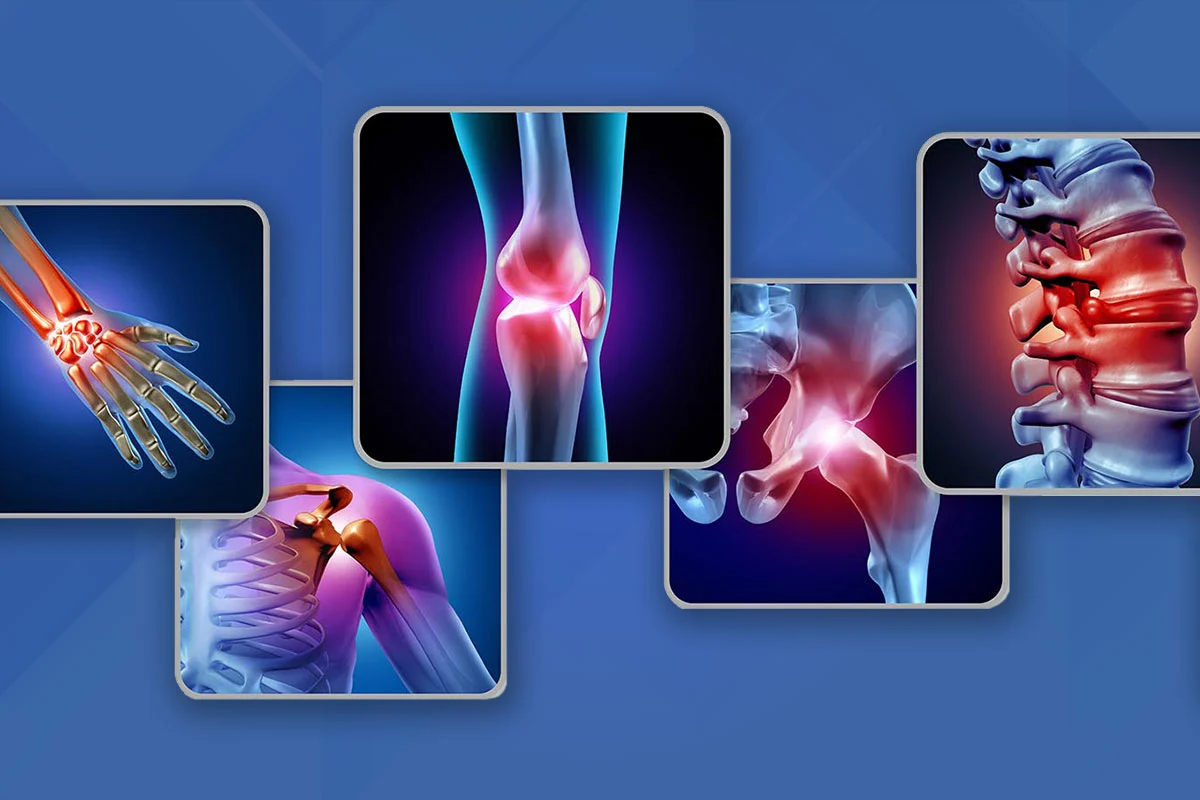It seems that the older you get, the more often you experience sore and aching joints when you stand up, climb stairs, exercise, or just simply get out of bed in the morning. A symptom of aging we all have to contend with eventually, age-related physical discomfort can have a multitude of causes, some of which potentially stem from the same source: A shortfall of crucial nutrients in your joints.
Article at a Glance
What Are Joints & How Do They Age?
- Joints are where your bones articulate or make contact
- There are different types of joints in the human body
- Joint discomfort increases as you age
- The connective tissue and cartilage between joints thins with age
- This deterioration could lead to age-related joint conditions like osteoarthritis
Curcumin & Boswellia For Joint Discomfort
- Turmeric is a major source of curcumin
- Curcumin has anti-inflammatory properties, and has been shown to improve joint discomfort
- Boswellia has been used for centuries in Asian and African medicine
- Boswellia’s anti-inflammatory properties also help with joint discomfort
Hyaluronic Acid & Magnesium
- Hyaluronic Acid (HA) provides lubrication in the joints
- HA also helps you retain collagen
- Magnesium is essential for HA synthesis
- Magnesium deficiency could be a risk factor in osteoarthritis
Vitamin D For Joint Health
- A lack of vitamin D has been linked to incidents of joint pain
- Vitamin D also plays a healthy role in your muscles, which support your bones and joints
Vitamin C For Joint Support
- Vitamin C supports cartilage and helps with collagen synthesis
- Vitamin C has also been shown to help with cases of gout, a type of arthritis
Practical Tips For Joint Health
- Practice proper posture
- Exercise
- Watch Your Weight
- Eat Right
- Drink Water
- Don’t Smoke
Indeed, a life full of movement can cause your joints to either wear down entirely or simply not perform the way they used to in your youth. Your joints strain to connect the bones in your body, support your weight, and basically enable your day-to-day activity. And as you age, this gets tougher and tougher to do—as your tendons, ligaments, and cartilage grow susceptible to inflammation, injuries, and the overall stress of being utilized so often.
What Is A Joint?
Let’s get the simple definition of joints out of the way before delving into the question of how they are connected to nutrition and influenced by age. A joint is one of the many points in your body where two bones make contact, and they are classified in two ways—histologically and functionally. Histologically is based on the type of connective tissue which is dominant in the joint and functionally is based on the amount of movement between the bones that form the joint.
The histological and functional classifications each encompass three types of joints. Based on histological, the three types of joints are fibrous, cartilaginous, and synovial. And based on function, the three types of joints are synarthrosis (immovable), amphiarthrosis (slightly moveable), and diarthrosis (freely moveable).
As for how many joints you have in your body, that can be a difficult question to answer, as it depends on a few factors. For starters, there’s some debate as to what actually defines a joint. Then there’s the question of sesamoids, which are bones that are embedded in tendons, but aren’t connected to other bones—like the kneecap. And finally, newborns start out with about 270 bones, and that number decreases to about 206 bones in adulthood.
Long story short, you might have anywhere from 200 to 400 joints in your body.
What Nutrients Support Joint Health As You Age?
It’s important to understand how your joints change as you age. Women can start to show signs of joint pain due to aging after age 50, while men are likely to see it before age 45. For both men and women, the connective tissue and cartilage between the joint can deteriorate over time. Bones begin to grind together without that vital connective tissue and cartilage, and this could potentially lead to osteoarthritis, which is the most common form of arthritis among older people.
According to the Centers for Disease Control and Prevention (CDC), more than 50 million adults live with some form of arthritis. Meanwhile, our aging population has projections showing that the number of adults with arthritis will rise to 60 million by 2020 and near 80 million by 2045. Indeed, the aches and pains of your advancing years are somewhat of an inevitability, but there are nutritional solutions that can help you manage some of that discomfort and support your overall joint health.
Some of the most important nutrients for joints include ones that are robust sources of anti-inflammatory properties, including curcumin and Boswellia. Then there’s hyaluronic acid, and a mix of other nutrients including magnesium, vitamin D, and vitamin C.
Curcumin & Boswellia For Joint Discomfort
Turmeric—the major source of the polyphenol curcumin—is a popular culinary spice with a double life as a highly celebrated herbal remedy option. As an antioxidant, curcumin has shown anti-inflammatory properties that counter the effects of oxidative stress. And with osteoarthritis, which has been associated with inflammation, curcumin has shown efficacy in several studies. For example, one randomized study demonstrated that curcumin significantly improved joint discomfort in participants with knee osteoarthritis.
Then there’s Boswellia serrata, which you might know as Indian frankincense. Resin made from Boswellia extract has been used for centuries in Asian and African folk medicine and has made its way into various products that can help to relieve inflammation. But how effective is it? One study found that participants with knee osteoarthritis reported a decrease in discomfort after receiving Boswellia, while also showing an increase in knee flexibility and how far they could walk. Meanwhile, a clinical trial showed that Boswellia extract can reduce pain and considerably improve knee-joint functions—in some cases providing relief within seven days.
The Connection Between Hyaluronic Acid, Magnesium, And Your Joints
Hyaluronic Acid (HA) is a clear and gooey substance that naturally occurs in the cells throughout your body, but levels begin to decline around age 40. HA, also called hyaluronan, is a major component of articular joint synovial fluid, where it provides the viscoelasticity and lubrication necessary for protection of cartilage surfaces. HA also helps your body retain collagen, which helps your body maintain cartilage integrity. And studies show that as the amount of collagen in your body decreases with age, your chances of developing degenerative joint conditions increases.
Meanwhile, according to a published report on HA by the International Journal of Research in Chemistry and Environment, magnesium is essential for hyaluronic acid synthesis, and a lack of this pivotal mineral in your diet could potentially cause low hyaluronic acid levels.
And beyond its connection to HA, magnesium has its own uses in joint health. Close to 60 percent of your magnesium is stored in your bones and low levels of the mineral could be a risk factor for osteoarthritis. This is yet more evidence that magnesium is perhaps one of the most overlooked—but essential—minerals in the pantheon of nutrients.
How Vitamin D Factors Into Joint Health
Vitamin D possesses anti-inflammatory properties that play an important role in how your joints function—and with vitamin D deficiency running rampant in our times, it’s no surprise that joints are aching around the world.
It’s the anti-inflammatory nature of vitamin D that have researchers studying the vitamin’s effectiveness in addressing joint discomfort, particularly in cases where inflammation is the major cause. In one review of studies, it was demonstrated that participants with forms of arthritis had less vitamin D in their blood than those without arthritic symptoms. Meanwhile, more research suggests that vitamin D deficiency has been linked to increased susceptibility to the development of rheumatoid arthritis.
Vitamin D also plays an important role in muscle health—which is your body’s natural support system for your joints. A study published in a medical journal demonstrates how vitamin D is related to muscle strength and size. The study showed that vitamin D, after it was activated in the body, was associated with muscle strength and lean body mass.
Vitamin C Works In Support Of Joints
While it’s usually associated with the common cold—and orange juice—the universally familiar vitamin C also works to support cartilage strength and help with collagen synthesis, the body’s most abundant protein in joint tissue and the glue that holds joints together. According to data collected in a study from 2017, adding vitamin C-enriched gelatin to an intermittent exercise program improves collagen synthesis and could play a beneficial role in injury prevention and tissue repair.
And then there’s vitamin C’s usefulness in addressing another form of arthritis, gout, which is caused by an excess of uric acid in the bloodstream. One massive study observed close to 50,000 men over a 20-year period and found that when vitamin C increased in the participant’s diet, the instances of gout decreased. Researchers suggested that vitamin C assists the elimination of uric acid from the kidneys.
Practical Tips For Maintaining Healthy Joints
Since you cannot halt the aging process, what are some other ways to keep your joints in tip-top shape so that the active nutrients mentioned above can do their job in keeping you flexible and feeling good?
Proper Posture Is No Slouch
For starters, the long-term effects of bad posture can put your joints at risk. When you slouch—especially while sitting hunched over at a computer—it puts pressure on your joints, inflicting a measure of damage. Make a conscious effort to straighten your back when sitting for long stretches of time.
Exercise, But Remember To Stretch
Physical activity can benefit your health, not only by keeping the blood flowing, but also by keeping your joints comfortable and agile. Sitting around and being generally inactive can cause your joints to become stiff, increasing joint discomfort and pain. Try some low-impact exercises like swimming or walking to keep those joints lubricated. Lifting weights can help as well, as it builds joint-supporting muscles. Just remember to lift with your legs, not your back! Also, stretch your muscles first before any exercise, as this will help you avoid strain.
Keep Your Weight In Check
If you’re carrying extra pounds, your joints are going to feel it. Weight can add stress to your joints, particularly to your knees and lower back—while all that extra stress on your joints can cause inflammation.
Maintain A Healthy Diet
When it comes to eating for your joints, you definitely want foods that boast anti-inflammatory properties. Leafy greens and fresh berries are the perfect daily dose of anti-inflammatory foods that can help stave off joint discomfort.
Stay Hydrated, With Water
Sodas, energy drinks, and alcohol might be fun, but they can work to dehydrate you and devastate your joints over a long period of time. This is why water should be your number one beverage choice every single day. When you’re out walking around, be sure to keep a bottle on hand for hydration at a moment’s notice. This keeps your body from pulling water from cartilage when you’re dehydrated.
Of Course, Don’t Smoke
If it seems like “quitting smoking” is important to just about every health condition, you’re right, it is. In the case of joint health, smoking increases inflammation and in turn, dials up joint pain. And interestingly, smoking changes the way your brain processes pain—which means you could be less aware of the damage you’re doing to your joints.
As You Age, So Do Your Joints
Sure, aches and pains are a part of adult life, but there are steps you can take to give your joints and bones a fighting chance against the ravages of time. Whether it’s nutritional support or more everyday practices, the efforts you make now to strengthen your joints can go a long way in dictating how your body feels in the future.









